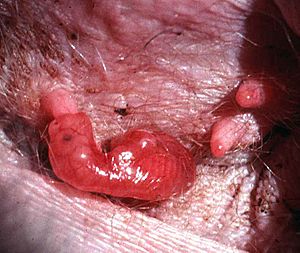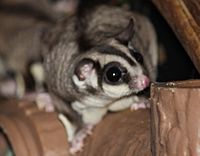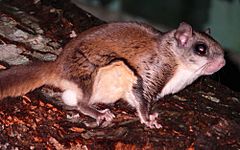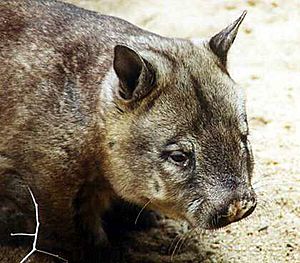Marsupial facts for kids
Quick facts for kids MarsupialsTemporal range: Lower Cretaceous – Recent
|
|
|---|---|
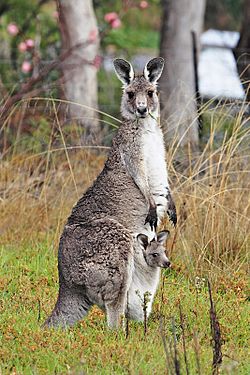 |
|
| Female Eastern Grey Kangaroo with a joey in her pouch | |
| Scientific classification | |
| Kingdom: | |
| Phylum: | |
| Class: | |
| Subclass: | |
| Infraclass: |
Huxley 1880
|
| Orders | |
Marsupials are a special group of mammals. They are part of a larger group called Metatheria, which also includes their ancient relatives that are now extinct. Marsupials are known for giving birth to very tiny, undeveloped babies. These babies then grow and develop inside a special pouch on their mother's body.
Contents
Reproduction and Life Cycle
Marsupials give birth to live babies, just like many other mammals. These tiny babies are called joeys. Joeys drink their mother's milk to grow. When they are born, they are incredibly small.
Most marsupials have a special pouch on their belly. After birth, the tiny joey crawls into its mother's pouch. Inside the pouch, it can drink milk and stay warm and safe. When joeys are very young, they stay in the pouch all the time. As they get older, they start to leave the pouch for short periods. Once they are big enough, they no longer need to go into their mother's pouch.
A joey is born in a very undeveloped state. It is blind, has no fur, and is about the size of a jelly bean. It crawls across its mother's fur to reach the pouch. Once inside, it attaches to a teat for food. The joey will stay in the pouch for several months, growing and developing fully. After this time, the joey starts to spend more time outside the pouch. It learns to find food and survive on its own. However, it will still return to the pouch to sleep or if it senses danger.
Joeys can stay in the pouch for up to a year in some species. They rely on the mother's pouch to keep them warm. The pouch temperature must stay around 30 to 32 degrees Celsius (86 to 90 degrees Fahrenheit). This is needed until the joey has enough fur and is old enough to leave the pouch.
Where Marsupials Live
Marsupials first appeared a very long time ago. This was before the southern supercontinent called Gondwana broke apart from Pangaea. Early marsupial fossils have been found in Asia, dating back 125 million years.
Over time, other mammals called placental mammals became more common in many parts of the world. Placental mammals did not reach the Australasian part of Gondwana before it separated. This is why most marsupials today are found only in the southern continents. You can find them in Australasia (like Australia and New Guinea) and in South America and Central America. The only exception is the Virginia opossum, which lives in North America.
About 100 different species of marsupials live in South America. Some of these have moved north. Thirteen species now live in Central America, and one species lives in North America.
There are 334 species of marsupials living in Australasia. Most of them are in Australia and New Guinea. Some also live on smaller nearby islands.
In more recent times, land bridges formed between the Americas. Also, placental mammals were brought to Australia by humans. These events have led to the extinction of many marsupial species.
Marsupial Family Tree
Scientists have tried to understand how different marsupial groups are related. There are over 300 living species. Studies sometimes differ on which group is the closest relative to all other marsupials.
One group, Microbiotheria, has only one species, the monito del monte. It lives in South America. However, its body structure suggests it is closely related to Australian marsupials. DNA studies in 2010 and 2011 showed that Microbiotheria is indeed the closest relative to all Australian marsupials. The relationships among the other four Australasian groups are still being studied.
The diagram below shows how different marsupial groups are related. It is based on a study from 2015.
| Marsupialia |
|
||||||||||||||||||||||||||||||||||||
DNA evidence suggests that marsupials first appeared in South America. Australian marsupials likely came from a single migration from South America to Australia across the ancient continent of Gondwana. Many small marsupial species in both groups live in trees. The word "opossum" usually refers to American species. Similar Australian species are called "possums".
Marsupial Body Features

Marsupials have the main features of mammals. For example, they have mammary glands (to produce milk), three middle ear bones, and true hair. However, they also have some important differences from placental mammals.
Besides the front pouch for their young, marsupials have other common body features. Most modern marsupials do not have kneecaps (patellae) made of bone. They also have special bones called epipubic bones. Marsupials (and monotremes) also lack a large connection between the right and left sides of their brain.
Skull and Teeth
The marsupial skull has some unique features compared to placental mammals. Generally, their skull is relatively small. The cheekbone is larger and extends further back. The lower jaw has a part that bends inward. Another feature is that their hard palate always has more openings.
Their teeth are also different from placental mammals. All marsupials, except wombats, have a different number of incisors (front teeth) in their upper and lower jaws. Early marsupials had many teeth, up to 50 in total. Some marsupials, like the opossum, still have this original number of teeth. In other groups, the number of teeth has been reduced. Marsupials often have 40 to 50 teeth, which is more than many placental mammals. They have many incisors in the upper jaw, up to ten. They also have more molars than premolars. Only the third premolar tooth grows in a second set; all other teeth are permanent from the start.
Torso and Pouch
Marsupials have unique bones called Ossa epubica. These are two bones that stick forward from the pelvis. Since both males and species without pouches have them, scientists believe they were originally for muscle attachment to help move the hind legs. Marsupial reproductive organs are also different from placental mammals, as their reproductive tract is doubled.
A pouch is present in most, but not all, marsupial species. Many marsupials have a permanent pouch. In others, like the shrew opossum, the pouch only develops during pregnancy. In these cases, the young are hidden by skin folds or the mother's fur. The pouch can be arranged differently to best protect the young. For example, kangaroos, which hop, have a pouch that opens forward. Many other marsupials that walk or climb on all fours have a pouch that opens backward. Usually, only female marsupials have a pouch.
Similarities to Other Animals
Marsupials have adapted to many different places and ways of life. This means they come in many different shapes and sizes. The largest living marsupial is the red kangaroo. It can grow up to 1.8 meters (5.9 feet) tall and weigh 90 kilograms (198 pounds). However, some extinct marsupials, like Diprotodon, were much larger. The smallest marsupials are the marsupial mice. They are often only 5 centimeters (2 inches) long.
Some marsupial species look very similar to placental mammals. This is an example of convergent evolution. It means different animals develop similar features because they live in similar environments or have similar lifestyles. For example, the extinct Thylacine looked a lot like a wolf, which is why it was called the "Tasmanian wolf." Both marsupials (like sugar gliders) and some placental mammals (like flying squirrels) developed the ability to glide through the air. Other groups, like kangaroos, do not have clear placental counterparts. However, they share similar lifestyles and eat similar foods to animals like ruminants (like cows or deer).
List of Marsupials
Australasia
- Bandicoots
- Kangaroos
- Koalas
- Tasmanian Devil
- Thylacine (Tasmanian Tiger)
- Wallabies
- Wombats
Thingodonta
The extinct Yalkaparidon (Order Yalkaparidontia) is a very strange fossil. It was found in Australia. Its teeth are so unusual that scientists call it a 'Thingodont'.
South America
No Longer Marsupials
Some animals, like the borhyaenids and the sabertooth Thylacosmilus, were once thought to be marsupials. However, scientists now know they are not true marsupials. They are part of a related group called sparassodont metatherians. This group is the closest relative to marsupials.
Related pages
Images for kids
-
Female eastern grey kangaroo with a joey in her pouch
-
Child holding rescued agile wallaby joey. Cooktown. 2008
-
Isolated petrosals of Djarthia murgonensis, Australia's oldest marsupial fossils
-
Phylogenetic tree of marsupials derived from retroposon data
See also
 In Spanish: Marsupiales para niños
In Spanish: Marsupiales para niños


